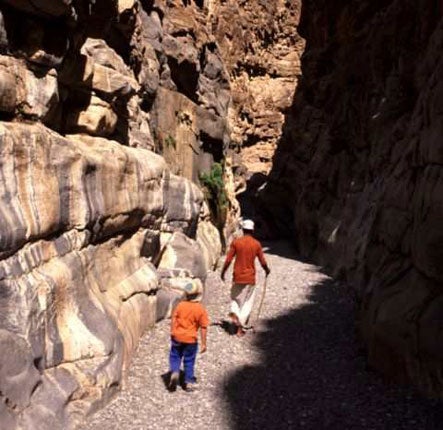Small steps through Oman's mountains
This trendy holiday spot isn't all about the beach. Amar Grover headed on foot into the interior – with his young family

Your support helps us to tell the story
From reproductive rights to climate change to Big Tech, The Independent is on the ground when the story is developing. Whether it's investigating the financials of Elon Musk's pro-Trump PAC or producing our latest documentary, 'The A Word', which shines a light on the American women fighting for reproductive rights, we know how important it is to parse out the facts from the messaging.
At such a critical moment in US history, we need reporters on the ground. Your donation allows us to keep sending journalists to speak to both sides of the story.
The Independent is trusted by Americans across the entire political spectrum. And unlike many other quality news outlets, we choose not to lock Americans out of our reporting and analysis with paywalls. We believe quality journalism should be available to everyone, paid for by those who can afford it.
Your support makes all the difference.The Sultanate of Oman has been busy luring visitors seeking winter sun to its coast, but a rather more low-key campaign has also been under way to coax us into the mountains.
The Jebel Hajar range arcs across northern Oman, from the United Arab Emirates border to beyond Muscat. Amid its stark ramparts lie remnants of "old" Oman: ancient villages and hamlets, venerable donkey trails and footpaths that echo a time not so long ago when travel required locals' permission and a tactful guide.
We – my partner and sons Amrik, four, and infant Dorian – based ourselves in Nizwa, a small town already on the tourist circuit with its fine old fort (and proximity to others), and marvelled at how barely 60 years ago the hardy Wilfred Thesiger's visit was thwarted by its fanatical and suspicious ruler. It is all so different now.
We began our explorations at Wadi Tanuf, one of many canyons that gouge their way spectacularly down through the Hajar. We had not planned to walk here but instead came to visit the crumbling remains of old Tanuf, bombed by an obliging RAF back in the 1950s during the Jebel War when, with British assistance, the Sultan was trying to gain control of this region. The part-ruined houses, clear alleys and mosque make for atmospheric wandering.
Yet the road winding round and behind Tanuf, past a small dam and into the canyon, proved unexpectedly alluring. Some 5km on, we parked the car, donned our boots and headed up a stony footpath with vast distant cliffs seemingly blocking the horizon.
Gurgling water and small vegetable plots heralded our arrival at Al Far village, where a few shy women and curious children gazed at us from windows and doorways. A beaming young man called Salah beckoned us to follow, helping Amrik cross streambeds as we navigated the village's little oasis of gardens and slender raised paths.
We clambered down into the main wadi, by now a narrow dry watercourse of bleached stones. It quickly narrowed into a deep box canyon that wound into the mountains, drawing us in until an impasse of boulders brought us to a halt.
Having enjoyed an enclosed wadi walk, we wanted a taste of the lofty Hajar. From Al Hamra, west of Tanuf, a good road weaves through Wadi Ghul before taking off into a 1,900m-high plateau. The trail to Jebel Shams – Oman's highest peak – starts here but we opted for the more child-friendly path to As Sab, an abandoned village perched on a ledge overlooking Wadi An Nakhar. Cutting deep into the mountains, this is often and justifiably called Oman's Grand Canyon.
We left our car by Al Khitaym hamlet and turned on to the almost hidden path. For about four idyllic kilometres it felt like strolling along a grand balcony with great shafts of rock and strata catching the theatrical play of afternoon light and shadow, and marvellous views across the wadi's abyss.
A young village girl, Shamsa, decided to follow us and she helped to enforce lane discipline, for this is a trail that demands care with children. While there were few precipitous drops beside the path, the rocky slopes towards the edge end in sheer cliffs.
Sab's isolation makes it feel abandoned, although locals still occasionally use their old stone houses there. A flour-grinding platform and terraces, a water pool and the falaj, or irrigation channels, all remain. Near a small cave house, a path heads up towards the base of a cliff and a terrifying-looking via ferrata up onto the plateau. When I explained it was a shortcut, Amrik exclaimed "Let's go, dad!" It took some persuasion before we happily returned the way we'd come.
Compact facts
How to get there
Return flights to Muscat with Oman Air (08444 822 309; www.oman-air.co.uk) cost from £334.
The Al Diyar Hotel (00 968 25 412 402; www.aldiyarhotel.com; web) in Nizwa offers double rooms from 25 Omani Rials (£43) per night.
Further information
Good guide books include the Bradt travel guide 'Oman' (£13.99), 'Oman trekking' (Explorer Publishing, £12.99), 'Adventure Trekking in Oman' by Anne Dale and Jerry Hadwin (Cordee, £15).
Join our commenting forum
Join thought-provoking conversations, follow other Independent readers and see their replies
Comments